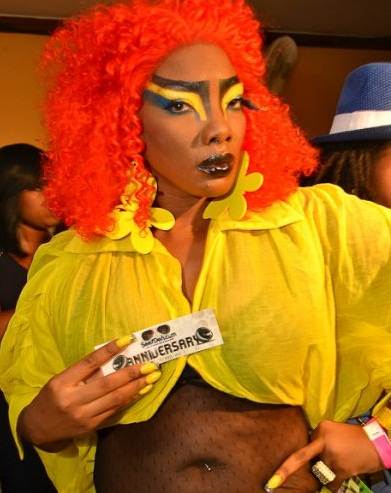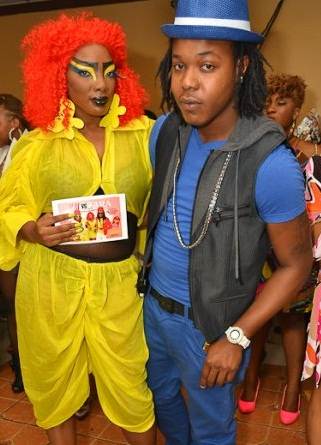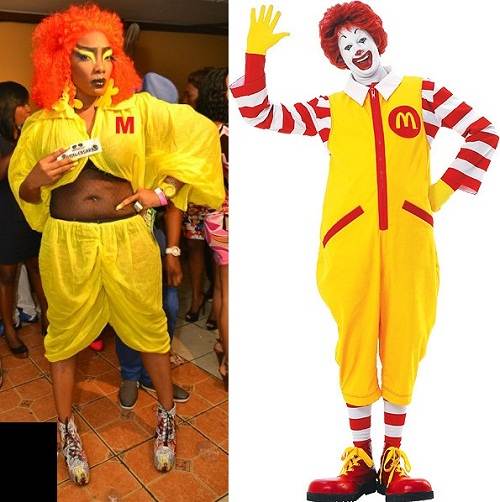Skin Bleach And Civilization: The Racial Formation of Blackness in 1920s Harlem
Skin Bleach And Civilization:
The Racial Formation of Blackness in

1920s Harlem
Jacob S. Dorman, Ph.D.
University of Kansas
Jacob S. Dorman ([email protected]) teaches African American History and American Studies at
the University of Kansas. He has been an NEH fellow at the Newberry Library and a Mellon
fellow at Wesleyan University, Connecticut, among other honors. His first book, to be published
with Oxford University Press, is entitled, Chosen People: African Americans and the Rise of Black
Judaism.
Abstract
Unlike previous scholarship on skin-bleaching advertisements
conducted by scholars such as Lawrence Levine and Kathy
Peiss, this paper finds those advertisements reflected
a definite and widespread preference for light skin among
African Americans in 1920’s Harlem. Newspaper records and historical archives
demonstrate that tangible if permeable boundaries existed between “black,”
“brown,” “light brown,” and “yellow” “Negroes” in 1920’s Harlem. Skin
bleaching was far more than merely cosmetic: it was a profoundly micro-political
form of self-masking and identity shifting mediated by the
new mass market. The advertisements not only appealed to the
desire to be beautiful but also to the desire to find a mate, get a
better job, and associate oneself with the future, modernity, and
progress. Skin bleaching was one practice in a universe of
speech and speech-acts that constituted an African American
version of the discourse of civilization.
At one extreme, skin-bleaching represented part of a “Great
White Hope” that lightskinned “New Negroes” might actually be
able to escape their “Negro” past and become a new near-white
“intermediate” race, as anthropologist Melville Herskovits
pronounced them in 1927. Uncritical reconstructions of a unitary
“black” subject position in 1920’s Harlem obscures the deep divides and antagonisms
based on class and color that striated Harlem society. Recognizing these truths suggests that multiple
“Negro” racial identities were constructed through quotidian actions
both pedestrian and potent.
Keywords: skin bleach, discourse of civilization, racial formation, W.E.B. Du Bois, Marcus Garvey
Introduction: Neither Simple Nor Sanguine
“To absorb a handful of Negroes in America and leave the
unbleached millions of Africa in their savage blackness would be
to deepen the gulf of racial cleavage as a world problem.”1 These
were the words of Kelly Miller, Dean of Howard University, in a
1926 newspaper column entitled: “Is the American
Negro to Remain Black or Become Bleached?” No outraged
letters to the editor followed, nor were Miller’s views out of step
with public opinion in the early decades of the twentieth
century. Miller’s comment illustrates that the practice of skin
bleaching was part of a much larger discourse of civilization, a
discourse that incorporated the uplift of Africa’s “unbleached
millions” and that allowed one of the most prominent African
American commentators of the day to seemingly offensively
entwine the words “unbleached,” “Africa,” “savage,” and
“blackness.” “Bleaching” was a potent double entendre,
referring either to
lightening the skin through bleach or through racial
“amalgamation.” In all senses, bleaching was complicated and
far more than merely cosmetic. Skin bleaching can’t be
understood in simple or sanguine terms, and it repels efforts to
pigeonhole it as either callow self-hatred or bold racial
resistance.2 Rather, the argument of this article is that bleaching
was part of seemingly contradictory ideas of progress, racial
advancement, and civilization.
African American skin bleaching practices in the 1920s
constituted a profoundly micro-political form of self-masking
and identity shifting mediated by both ideology and
consumerism. The mask of face bleach exposes some of the
other
masks that Black folk assumed and fought over in that turbulent
decade, as they struggled among themselves to define the
boundaries and definitions of “the race.” Skin bleaching was
thus a part of an embodied and everyday Black mass discourse
of civilization that illuminates disagreements between titans such
as
W.E.B. Du Bois and Marcus Garvey as well as the alchemy of
racial transformations performed as everyday, private ablutions.
If the formation of African American identity and the racial
formation of Blackness proceeded not as a seamless natural
evolution but through a series of incremental, politicized
discourses, then skin bleaching helps to stain and delineate one
chapter in the racial formation of African Americans.3
Bleaching as a Contested Social Text
The larger context of the cosmetics, hair straighteners, bleaches,
and beauty regimens of the 1920’s was a mass market that
targeted the new generation of young African American women
working in wage labor in cities of the North in the wake of the
Great Migration. Oftentimes created and marketed by African
American women themselves, skin bleaches and hair
straighteners created fortunes worth millions and accounted for a
massive thirty to fifty percent of all advertisements in the Black
press of the decade.4 Containing caustic chemicals such as
hydroquinone, which suppressed the production of melanin in
the skin, skin bleaches could cause severe dermatitis and even
death in high dosages. The power of skin bleaching as a social
text resides partly in the fact that it was part of an intimate,
quotidian, private, and largely un-remarkable ritual, something
hundreds of thousands of people did between washing their
faces and brushing their teeth. Bleaching was a form of self-
fashioning, an autobiographical revision of race performed on
the surface of one’s own body. While lightened skin could
enhance social mobility inside and outside of the Black
community, the practice was also quite literally a form of
disfigurement. James Baldwin wrote of his own twenties Harlem
childhood that popular discourse frequently connected Africa’s
Blackness with her lack of civilization, and attempts to alter
appearance were characterized by shame, rage, pain, and a lack
of positive images of Africa and African Americans:
At the time I was growing up, Negroes in this country were
taught to be ashamed of Africa. They were taught it bluntly, as I
was, for example, by being told that Africa had never
contributed “anything” to civilization…. One was always being
mercilessly scrubbed and polished, as though in the hope that a
stain could thus be washed away…. The women were forever
straightening and curling their hair, and using bleaching creams.
And yet it was clear that none of this effort would release one
from the stigma and danger of being a Negro; this effort merely
increased the shame and rage. There was not, no matter where
one turned, any acceptable image of oneself, no proof of one’s
existence.5
Baldwin’s memory of the connection between Africa’s
blackness, its lack of civilization, and the bitter bodily disciplines
of washing, bleaching, and processing demonstrate that
bleaching helped to stave off what Miller called the “unbleached
millions of Africa in their savage blackness.” The physical and
psychological pain associated with skin bleaching belies attempts
to minimize it or to valorize it as a form of social resistance. The
practice can be better understood in terms of the African
American discourse of civilization and related debates over the
meaning of Blackness.
Scholars working in African American Studies and African
American History have demonstrated how ideologies of race,
gender, uplift, and respectability functioned to shape the Black
public sphere of the early twentieth century.6 All of these
discourses are important constituent parts of what can be
thought of as an African American discourse of civilization. The
concept of civilization encompassed one of the key clusters of
ideas in the Progressive Era, uniting ideas relating to science,
industrialization, consumerism, modernity, race, religion, gender,
evolution and empire, thereby forming a set of received ideas
about what it meant to be civilized. As Matthew Frye Jacobson
writes, the idea of “civilization” in American thought has
historically been “a dense weave of ideas and assumptions
regarding not only proper comportment, manners, social bearing,
and Judeo-Christian belief, but also regarding the fundamental
social issues of property relations, the distribution of wealth,
modes of production, and patterns of consumption.”7 The
African American version of this discourse, which deserves
further explication, sometimes used the dominant discourse in a
recalcitrant manner, as when Ida B. Wells and other
commentators activated its language to accuse white lynch mobs
of being savage, barbaric, and uncivilized.8 The dominant if not
hegemonic discourse of civilization among so-called Negroes in
the late nineteenth and early twentieth centuries connected
Africa to primitiveness and savagery.9 Nevertheless, African
American discourses of civilization of the twenties conceded the
primacy of white constructs of civilization, without conceding
the primacy of whites. Civilizationism, unlike other forms of
white supremacy, offered Blacks a route to greater freedom.
Whereas scientific racism forever confined Black people to
positions of inferiority due to alleged natural qualities, and
Christian racism damned Blacks due to the curse of Ham, the
discourse of civilization at least gave African Americans a
chance to achieve equality by attaining civility.10 As Kelly Miller
wrote in 1905:
A young race, just like the individual, must first appropriate
and apply what has already gone before. The white man has no
exclusive proprietorship in civilization. White man’s civilization
is as much a misnomer as the white man’s multiplication table.
It is the equal inheritance of any one who can appropriate and
apply it.11
Class, color, race, and region all inflected African American
selfpositioning within or against the discourse of civilization and
the practice of skin bleaching. In her study of Black women in
interwar Detroit, Victoria Walcott argues that the self-contained
nature of segregated Black American communities
increased the circularity of values therein, so that the ideology of
respectability was not confined to elites alone.12 A similar
circularity of values adheres in the case of the discourse of
civilization. The desire to be civilized and the desire to
expand and change what it meant to be civilized can be found
across all classes and strata of Black life. Nonetheless, the
signifiers connecting light skin with advanced civilization were
typically densest among the middle and upper class segments of
the Black population.
“The Aristocracy of Color:” Black Colorism
in the 1920s
As early as the middle of the nineteenth century, integrationists
among Black Bostonians emphasized complexion rather than
race, claiming the term “colored” rather than “black” or
“African.”13 Not only did the Black community have “no broadly
accepted new paradigm on race” in the early twentieth century,
as Mia Bay has demonstrated, but the multiple and overlapping
Black communities also debated Blackness itself.14 The debates
continued in the late nineteenth and early twentieth century,
with W.E.B. Du Bois, Booker T. Washington, T. Thomas
Fortune, Alexander Crummell, John Edward Bruce and others
all weighing in on the question of what to call people of African
descent.15
AMEN
Monday, July, 23RD 2012 – A Mombasa bishop said that the gay community poses a far too greater threat than terrorism in Kenya. Bishop Julius Kalu of the Mombasa Anglican Church told his congregation which included Mutava Musyimi, a Presidential aspirant and Gachoka MP that Christians are now challenged by “the enemies of the Church’’ mainly homosexuals and lesbians and terrorism was a lesser threat compared to the first two.
The bishop said, “our greatest fear as a church should not be the grenade attacks, but the new teachings like same sex marriages. Christians should be spiritually armed to confront the challenges.’’
Bishop Kalu was out of the country for about two months during which the debate on gay unions has raged across Coast Province where the practice is prevalent. He was responding to an incident of a grenade attack on Christians in a church in Mombasa and another one in Garissa.
The terror attack in Garissa happened on July 1 where 17 lives were claimed including a Muslim policeman in a hail of bullets on two churches in Garissa. Yesterday, Kalu and Musyimi said Christians are now living in fear after the attacks and are not to attend Sunday service. According to Kalu, terror attacks and crusade for gay unions is a double edged sword pieced through the heart of the church. He added that attendance has dropped in recent times.
“The congregation does not close eyes in prayer for fear of grenade attacks however what the congregation should fear most is new liberal teachings allowing same sex marriages,’’ Bishop Kalu claimed during his sermon at ACK Memorial Cathedral.
He said that the gay movement has eroded moral logic that threatens to cripple the church by introducing unacceptable teachings in the name of freedom of worship and association.
“The church is at war with an enemy of faith and the enemies are those who are changing the Christian doctrine. So Christians must be fully armed and spiritual as it is only divine intervention that will enable the country overcome these challenges,’’ the bishop said.
THE FALLACIES OF APPEARANCE AND MANNER- GOODMORNING
The fallacies of Appearance and Manner
One of the easiest ways to misjudge a person, place or thing is by its appearance. But what we often fail to recognize is that placing too much faith in appearances is fundamentally illogical. A handsome politician is more likely to be elected because of people’s feeling that he looks like he would make a good leader, when in reality he might be incompetent. If a salesman is dressed well, people are more likely to buy from him, having more confidence in him than if he were dressed poorly. Yet what logical correlation exists between his appearance and the quality of the product or service that he sells? Basically, none.
There is nothing wrong with a wholesome appearance, and indeed we should try to put our best foot forward. As the saying goes, we never get a second chance at making a good first impression. But when appearance becomes the sole or even primary basis upon which one decides to buy or believe something or someone, a fallacy is committed and one is acting irrationally. Con men deceive many people by appealing to just this sort of person, who judges not by the merits of the product or idea itself, but by the appearance and manner of the person promoting it.
There are many examples of this fallacy in God’s Word, and it plays a large part in man’s difficulty in walking by the spirit or living by the revealed Word of God instead of his five senses. The more the believer can train his mind to think logically and not make superficial judgments on the appearance of things, the more effectually he will walk by the spirit. 1 Samuel 16 is the record of Samuel choosing a king from the sons of Jesse, and being deceived by appearances.
1 Samuel 16:6 and 7 (KJV)
(6) And it came to pass, when they (the sons of Jesse) were come, that he looked on Eliab, and said, Surely the Lord’s anointed is before him.
(7) But the Lord said unto Samuel, Look not on, his countenance, or on the height of his stature; because I have refused him: for the Lord seeth not as man seeth; for man looketh on the outward appearance, but the Lord looketh on the heart.
Sound thinking is a prerequisite to acquiring consistent spiritual perception and awareness. Before a believer can very effectually operate the revelation manifestations of the spirit (A message of knowledge, A message of wisdom, discerning of spirits), he must get to the point that he is not deceived by the five senses. One of the principal ways he is misled by the senses is by the irrational regard for the appearance of things without looking deeper for the real intent or meaning behind an action or event.
This is well illustrated by Peter’s stand which he took against Ananias and Sapphira in Acts 5.
Acts 5:1 and 2 (KJV)
(1) But a certain man named Ananias, with Sapphira his wife, sold a possession, and kept back part of the price,
(2) his wife also being privy to it, and brought a certain part, and laid it at the apostles’ feet.
These believers looked very sincere and religious, selling a possession that they need not have sold to give to the outreach of God’s Word. The appearance of their action was very good indeed, but their hearts were not right, because they gave it more to please men than God. Had Peter been walking by his five senses he would have been deceived. But he was not only spiritually sharp to receive from God the information that they were lying, he was thinking logically. This kept his heart open to receive such information. Generally, revelation starts where the five senses end. What one can know by his senses God expects him to know. And certainly one thing God expects man to know is that appearances are deceiving, and not to be regarded as any necessary indicator of credibility or truth.
Manner
As mentioned, another fallacy similar to appearance is manner, in which one is led to believe that an assertion is true because the one asserting it is very sincere or confident in his manner. This is a very persuasive tool, even employed by many Christian teachers whose bold and confident manner deceives many. Certainly confidence and sincerity are important qualities for Christian believers and leaders to possess. But one may be sincerely in error, or with the greatest of confidence assert a lie. Therefore, God’s people should not be overly awed at the bold and confident manner in which a teacher or preacher speaks, and take a good look at what is actually being said in light of God’s Word, which is the only standard for truth.
One should never be overawed by the manner in which a statement is presented to the extent that he believes without first understanding or investigating what is said. Simon the sorcerer had bewitched the people of Samaria with his sorceries and with his confident manner as is recorded in Acts 8:
Acts 8:9 (KJV)
But there was a certain man, called Simon, which beforetime in the same city used sorcery, and bewitched the people of Samaria, giving out that himself was some great one.
The people of Samaria were hoodwinked by his self-confidence. To the extent that they were swayed by his confident manner they were acting irrationally. It is certainly appropriate for someone who knows and speaks the truth to speak with confidence and authority (Matt. 7:29, Mark 1:22). But people are acting irrationally if they accept what is said solely or primarily on the basis of the manner in which it is presented. Such acceptance is usually short-lived anyway, enduring only as long as the person who is convinced is personally present. People need to be grafted to the truth of God’s Word, the actual substance of the teaching, rather than being persuaded by the confident manner of a particular speaker. It is fundamentally irrational to accept a proposition without rational thought on the basis of the manner in which it is taught.
Sincerity is an important facet of this fallacy of Manner. Often a person can persuade others by convincing them that he is convinced, and not by providing supporting evidence. To the extent one is swayed by a person’s sincerity apart from evidence he is acting irrationally. The Berean believers were not overly awed by the Apostle Paul’s convictions, and rather than being thought foolish and skeptical, Scripture calls them “noble.”
Acts 17:11 (KJV)
These [Bereans] were more noble than those in Thessalonica, in that they received the Word with all readiness of mind, and searched the scriptures daily, whether those things were so.
The Apostle Paul was intensely sincere in his desire to go to Jerusalem, and had persuaded himself that he was right. Although God warned him repeatedly not to go, he was determined that it was something he had to do, and he had his course of action well rationalized. Rationalization is quite different from rational thinking, however. When we rationalize, we start with our assumptions and then come up with reasons to do what we already want to do or did. Rational thinking is to think about one’s course of action before acting based upon whether such action will be profitable, in one’s best interests, the will of God, etc.
Acts 20:22-24 (KJV)
(22) And now, behold, I go bound in the spirit unto Jerusalem, not knowing the things that shall befall me there:
(23) Save that the Holy Ghost witnesseth in every city, saying that bonds and afflictions abide me.
(24) But none of these things move me, neither count I my life dear unto myself, so that I might finish my course with joy, and the ministry, which I have received of the Lord Jesus, to testify the gospel of the grace of God.
Was he sincere? He certainly was, but he was also dead wrong, and nearly lost his life outside of God’s will. He allowed himself to be deceived by his own sincerity. To the extent one believes something without evidence or justification but solely or primarily on the basis of sincerity, he acts irrationally. Had Paul been logical in his thinking at this point, he would have looked more objectively at his proposed course of action and weighed the benefits and the consequences before he made a decision. As it was, though, he erred because he so believed that he was right that he blinded himself to the many reasons that were presented to him not to go. He went “bound in the spirit,” indicating that God was trying to tell him not to go. His illogical thinking, swayed by this fallacy of manner, prevented him from receiving the guidance he needed from God.
We can conclude from this and many other biblical records that logical thinking is often a necessary condition to receiving revelation. This means that we not be deceived by anyone’s appearance or sincerity, even our own. Sometimes self-deception is difficult to overcome precisely because we are blinded by our own sincerity and “good intentions.” Logical reasoning helps us get to the truth, however painful it may be in the short term.
****RULES**** 1. Debates and rebuttals are allowed but disrespectful curse-outs will prompt immediate BAN 2. Children are never to be discussed in a negative way 3. Personal information eg. workplace, status, home address are never to be posted in comments. 4. All are welcome but please exercise discretion when posting your comments , do not say anything about someone you wouldnt like to be said about you. 5. Do not deliberately LIE on someone here or send in any information based on your own personal vendetta. 6. If your picture was taken from a prio site eg. fimiyaad etc and posted on JMG, you cannot request its removal. 7. If you dont like this forum, please do not whine and wear us out, do yourself the favor of closing the screen- Thanks! . To send in a story send your email to :- [email protected]







Recent Comments